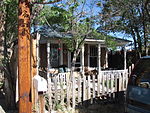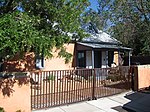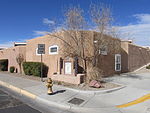Park Plaza Condominiums

Park Plaza Condominiums is a residential high-rise building in Albuquerque, New Mexico. At 160 feet (49 m) in height it is the 15th-tallest building in the city, as well as the tallest residential building in New Mexico. The 14-story tower originally consisted of rental units but was converted to condominiums in 1979. It is located one block south of Central Avenue, just west of Downtown. Park Plaza was constructed in 1963–4 at a cost of $2.5 million. With 144 one- and two-bedroom luxury apartments, it was the largest apartment complex in Albuquerque at the time and was described in a contemporary advertisement as "the Southwest's most beautiful and modern apartment building". Following the conversion to condos, many of the units have been renovated by their owners or combined to form larger units.
Excerpt from the Wikipedia article Park Plaza Condominiums (License: CC BY-SA 3.0, Authors, Images).Park Plaza Condominiums
Park Avenue Southwest, Albuquerque Old Town
Geographical coordinates (GPS) Address Website External links Nearby Places Show on map
Geographical coordinates (GPS)
| Latitude | Longitude |
|---|---|
| N 35.087361111111 ° | E -106.66277777778 ° |
Address
Park Plaza Condominiums
Park Avenue Southwest 1331
87102 Albuquerque, Old Town
New Mexico, United States
Open on Google Maps








